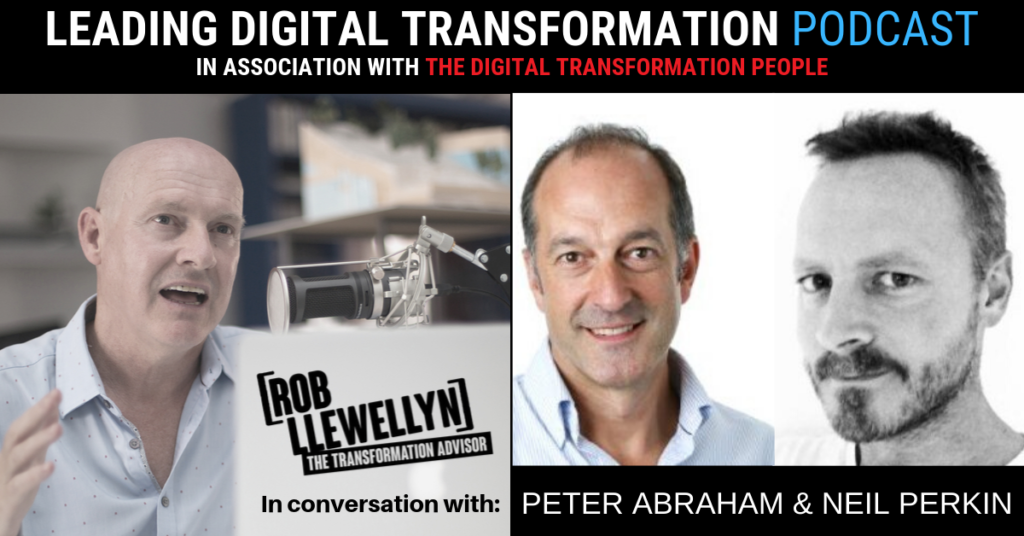‘Leading Digital Transformation’ is a weekly podcast series produced in collaboration between The Digital Transformation People and Rob Llewellyn digital transformation advisor and founder of CXO Transform.
During this series, Rob interviews experienced practitioners, authors and thought leaders whose stories and experiences provide valuable insights for digital transformation success.

In this episode, Rob speaks with Neil Perkin and Peter Abraham, authors of the acclaimed book ‘Building the agile business through digital transformation’ as they explain how the components of Velocity, Focus, and Flexibility combine to form the basis of a formula that can help leaders achieve business agility.
Agility = (Velocity x Focus x Flexibility)
“Simple things like initiatives that deliver quick wins are powerful as they give stories, clarity and an understanding of what good really looks like.” Neil Perkin
Listen here and read the full transcript below.
Transcript
Rob Llewellyn [00:00:22] Hi and welcome back. I’m joined today by Peter Abraham and Neil Perkin. They’re the authors of the book “Building the Agile Business through Digital Transformation”. They wrote the book to capture and share their own experiences of digital transformation projects since 2009 and share it with others who might also be approaching digital transformation. And they believe digital transformation is fundamentally about agility. Let’s jump into the interview with Peter and Neil to hear why ultimately what you need as a business is agility, to move quickly and easily to a position an advantage. So, Peter, Neil, welcome!
Peter Abraham [00:01:04] Hello, Rob.
Neil Perkin [00:01:05] Thank you, hi.
Rob Llewellyn [00:01:06] Guys, before we get into the depths of what I know you’re anxious to talk about with me today, you published a book and I know we’re going to cover some of the content in the book as we go through this talk, but the book’s called “Building the Agile Business through Digital Transformation”. Tell us what inspired you to write the book.
Neil Perkin [00:01:27] Well I guess if I can just kick off actually, I think one of the observations that I had when we wrote the book was that there was lots of material out there. I think it was focussed on the “why” of digital transformations, so why companies need to change, the kind of impact of technology, the need to become a different type of organisation. But there was very little around “how”, very little. So, we set out really to write a book that focussed on the “how”, to give leaders the kind of tools and the thinking and the models and the frameworks that they needed to help them understand a way through the kind of complexity which sits around digital transformation. So, much more about the “how” rather than the “why”, I think.
Peter Abraham [00:02:09] Yeah. And I think Neil and I had worked together quite a lot, probably since about 2009 on what were kind of transformation projects. Nobody really turned that digital transformation, but it was transformation through digital. And we’d amassed quite a lot of insight. We thought wouldn’t it be good if we could share this, not so much as a kind of bible, but almost as a stick in the sand to say: “This is what we’ve seen. What are you guys seeing?”. So, because a lot of people were still talking about technology and we thought it was definitely more about people.
Neil Perkin [00:02:40] I guess the other thing as well is that agile has become such a thing within companies. And clearly there was an opportunity to take the kind of principles and apply the principles outside of just technology teams, outside of software development and so what we were seeing in companies was very much a desire to become much more agile as a kind of way of operating. And so, the opportunity to kind of scale that much more broadly across the business and drive transformation through the application of those kinds of principles I guess is the kind of third element of that.
Peter Abraham [00:03:13] Yeah. As we were kind of writing it, this was another thing, the topic of digital transformation and we thought actually it was more about the building an agile business (which we’ll get into) more so than it was about kind of digital transformation.
Rob Llewellyn [00:03:30] Neil, you mentioned that agile has become quite a thing now, which of course most people listening will agree with. What kind of response have you had? You know, since writing the book and since agile has become that thing out there, what kind of response have you had to the book?
Neil Perkin [00:03:46] I mean it’s been an amazing response, actually. So, the publishers, Kogan Page, have said that it’s one of their best-selling books. And so, it’s been really successful in terms of the demand for it. But I think beyond that, I think really the thing which companies are really after, what they want to understand are the challenges, how they can navigate the challenges around a transition from more traditional ways of thinking and working and operating, so more linear waterfall-based ways of thinking, which are so entrenched within organisations with the way in which not just you build software but also the processes of an organisation, the way in which make business cases, the way you assess value, the way you fund projects, the way you run H.R. processes. It’s all very linear. And of course, the problem with that is that the context surrounding the organisation is changing far more rapidly.
So, the need to become more responsive, adaptive and more agile, companies recognise that that’s where they need to be. But the challenge of making that happen is very real. You know, you’ve not only got process challenges, knowledge challenges, skills challenges, but you’ve also got mindset challenges, cultural challenges, behavioural challenges and so, I think the response we’ve seen is very much a desire (which is no signs of going away, I think) for companies to really understand again how they can make that transition and how they can scale agile working and thinking much more broadly across their business.
Rob Llewellyn [00:05:09] So let’s open the cupboard to the book a little. In the book, you talk about “agility equalling velocity times focus times flexibility”. Let’s start with building velocity. Talk to us about that.
Neil Perkin [00:05:21] So I guess here in the velocity section, we’re really talking about the whole application, scaled application of agile principles and the need to shift to a far more kind of learning, iterative approach, so the ability to advantage moving from the idea of scale and your leveraging scale and everything that comes from that to one way or actually learning fast at scale. So, the kind of leverage that you have is not only a factor of how long you’ve been in the market, the number of people that you have, the amount of budget you’ve got. But it’s also about how you can learn and learn quickly and then apply those learnings and actually grow and change and adapt. So, it’s very much about taking that kind of principle of how agile works and then applying it at scale to how you need to operate differently as an organisation to empower continuous experimentation, continuous innovation, not episodic innovation or experimentation but to scale it much more broadly across the organisation.
Peter Abraham [00:06:23] Yeah, I’d agree with that, that kind of focus on learning, the ability for organisations to become more transparent, I think that’s probably one of the biggest things in terms of kind of blockers that they come up against is the ability to be more transparent, share results, particularly across global organisations, because that’s quite hard.
Neil Perkin [00:06:42] I mean, I think it’s important to say, in the book what we don’t say is that agile is suddenly the default process across the entire organisation. But in general, it’s much more about making smart choices and decisions about where you apply more linear-focussed approaches, safe to fail. So, where can you not fail? You need to be “that’s more checklist-driven”, “that’s more linear-focussed on you’ve got to do things right in those areas”. But then there’s plenty of other areas of business where you can be far more iterative, adaptive, learn fast and emergent in your strategy. And so it’s about understanding across the business what that looks like for you, where you can apply more agile principles, where you can scale them, how you can scale them, but also then, where you need to be more linear, where you need to be more efficiency-based, for example, so about making smart choices, really.
Peter Abraham [00:07:32] Yeah, you see people talk a lot about speed as well and speed is probably the wrong word. There’s that old phrase: “more haste, less speed”. But yeah, I don’t think that’s necessarily true. It’s not really about speed, it’s about focus and how you maintain pace.
Neil Perkin [00:07:46] That’s a good point about speed actually, isn’t it Peter, because I think you hear a lot of leadership teams grasp hold of agile as a way of delivering more stuff quicker, speed-to-market, doing the same amount that you’re doing before but with less people and often an output of applying agile at scale is that you do things quicker, that you are more productive in that you are actually increasing your speed-to-market, but it’s not the only thing and I think the danger is that companies miss that opportunity they have to be truly manoeuvrable at scale, to be responsive and actually far more adaptive and fluid and flexible so they’re able to adapt to rapidly changing contexts very quickly.
Rob Llewellyn [00:08:23] There’s been a rapid uptake of the concept of agile in the technology space. But in your observations, when you go into organisations, what’s been your experience of the organisation, the business side of the organisation, technology aligning on their approach to agile, particularly as I said because the agile approach is being adopted by a lot of technology folk now? What about the business side? How are they aligning?
Neil Perkin [00:08:49] Well it’s an interesting question, because I think there are so many different versions of agile, you know with XP and Kanban and Scrum and different methodologies and I encourage leaders really not to get lost in the methodology, because I don’t think it’s that helpful. And actually, every company context is different and every situation is different. So, it’s actually more helpful I think to the companies to find their own version of what that looks like and then to do what works for them. And often the way that they can do that is to actually be agile about how you do agile. So, you actually learn fast about the best way of doing things for you and you create processes and structures and things that actually work to apply these kind of principles at scale.
Peter Abraham [00:09:32] Yeah, and agile and Lean from a technology perspective is really well-defined, it’s been around a long time. But from a business perspective, it isn’t. That’s why one of the first things we did (which is also in the book) is outline what that agile business manifesto is, what it actually means. So, using customer experience and –
Neil Perkin [00:09:52] Yes, it’s easy to get lost in the methodologies, isn’t it? But for us I think, the most of it is about just understanding the application of the basic principles of what’s happening here. A lot of that is about a culture, mindset, but a lot of it also is about the practice of retrospective and reflection, for example, taking your learnings as you go, the practice of reprioritisation and breaking down a big thing into small things, iterating around customer and business value and regular reprioritisation of that and all the kind of working practices that sit around agile are just really useful ways of driving transformation across an organisation, of supporting better change, doing things quicker, all the things that companies are wanting to do right now. This I think is a really good way of them actually scaling that more broadly across the organisation.
Rob Llewellyn [00:10:41] I’d like to go back to the components that you use in your formula for building an agile business. One of those is focus and you talk about driving focus in the book. Can you elaborate on that?
Neil Perkin [00:10:54] One of the dangers, of course, is that when you’re introducing agile at scale, you potentially have lots of small multidisciplinary teams working on different things. So, you have the danger of running off in lots of different directions. And so, it’s quite often actually sometimes when we’ve done Agile implementations or transformation programs in companies, you hear teams saying: “we don’t need to plan, because we can just be agile, we can adapt, we can just flex.” And that’s quite dangerous, because of course you need that sense of direction.
So, one of my favourite quotes about that is Jeff Bezos who talks about “stubborn on vision, flexible on details”. And it’s about having the balance between vision and iteration. You need that good sense of direction for where you’re going, that vision has got to be compelling, it’s got to be communicated well, everybody in the business has got to understand what that vision is, what it means, it’s got to be emotional and [have] emotional connection to ensure people are actually really enthused by the vision, but also then what you got to do is to adapt and flex in your delivery of that vision. So you’re not rigid, you’re not linear, you’re not taking a waterfall-roadmap approach to the delivery of what you’re doing.
Peter Abraham [00:11:58] Yeah, focus is actually is really hard, because quite typically you’re going to be in a smaller team, you’re going to be asked to be more innovative, so you’re pushing those kind of creative buttons inside your head. So to then move from that to a real focus, which is the thing that kind of drives growth, is hard for most people.
Rob Llewellyn [00:12:16] We’ve spoken about two of the components, velocity and focus, and the third component is flexibility, and by the way, I really like the simplicity of this approach. Talk us through the third component: flexibility.
Neil Perkin [00:12:30] I mean the way we position flexibility is very much about fast and focus is really focussing on the how you scale these kind of principles wide across an organisation and do it well and make smart choices about where to do it and where not to do it. But flexibility is really about creating the culture, the leadership, the resourcing that you need in order to do it at scale. So, I guess you could say this is about being agile not just doing agile. And so, culture is one of the key barriers I think, potential barriers, that quite a lot of organisations bump up against when they’re trying to do this sort of stuff at scale. And so, you know there are definite ways in which you can think about promoting behaviours that really work, leadership kind of approaches and behaviours again that can kind of model the right behaviour, but also flexibility and fluidity of resourcing, the idea of small teams driving big change in your organisation and how you can flex up and down, and have that adaptability around your own resourcing as well.
Peter Abraham [00:13:29] Yeah. There’s also the -, because that plays into the autonomy piece, giving teams and people the autonomy which kind of translates into transparency (that’s what I was saying earlier about the transparency piece). There was a piece of research came out of the US, I think it was about two years ago, that said by 2021, 50 per cent of the big organisation workforce would be contracted. You think of the impact of that to even H.R. departments, how you deal contractually with people that are coming in and out, trying to align those people with vision and strategy for what you’re trying to do, whilst you’re building these other kinds of smaller components to combat disruption.
Neil Perkin [00:14:10] So what we’re saying here is that unless you have the kind of cultural enablers, then it’s very difficult to really scale this effectively across the organisation and for it to drive transformation in the way that it needs to. So you’ve got to have the right kind of behaviours and culture to support the working environment in which people can really do their best work, in which they can collaborate horizontally really well, in which they can actually flex and that balance that Peter’s talking about between alignment and autonomy (which is just kind of a Spotify thing) is really critical. So, you’ve got to go in the right direction, but also you need to empower enough autonomy for the teams that they can make fast decisions, that they can move quickly. And so, all the things that you can do as a leader to set your teams up for success, that’s what we’re really talking about in that bit.
Rob Llewellyn [00:14:56] And how have you found organisations adapting to this in order to encourage that new culture? Obviously, you go into organisations with recommendations on how they can do this, but we’re talking about people, human beings and behaviours which is really difficult. How do you get these organisations to evolve their cultures in the way which is required for agile to work for them?
Neil Perkin [00:15:21] Yeah, I mean a lot of it for me starts with the senior leadership team and the kind of behaviours and approaches that they model and the understanding that they have. A lot of people use the words that sit around agile and it’s almost to the point of being unhelpful. It’s just become a thing in companies. And so, we spend time making sure that leadership teams really understand what those principles mean and then how you can apply them at scale and then actually the kinds of behaviours that need to happen, not just across the organisation and the kind of environment you’re creating, but also what kind of behaviours that you should be showing as a leadership team, as a senior leadership team, and then what should you be expecting, what are the kind of questions that you need to be asking and how should you be responding to certain situations and enabling your teams to a space that they need while also making sure they’re going in the right direction. So, it’s about the role of leadership and actually how the role of being a leader in a digital native business, what that looks like. It’s a definite behavioural, cultural thing, I think.
Peter Abraham [00:16:20] Yeah, one other way you can do it is, you know, you can actually do an assessment and show them what their current culture is and then ask them what they think their culture should be. And then if you’re with an organisation because of that whole kind of innovation-transformation thing, where you’ve got smaller agile teams, potentially you end up with this dual operating system. So, you’ve got business-as-usual and then you’ve got these other teams building-the-new, if you like. So being able to show them where they need to change, – because changing culture is a big thing, it’s massive, it’s a big thing. It’s going to take a long time. You can’t do it overnight. It takes years, but it’s easier to do it in a smaller team. If the teams are smaller, the communications are faster.
So, what you’re trying to do is to show them where they need to change. So at the moment, we have this kind of a framework for eight types of different behaviours that you can hone in on, the typical one is kind of lack of communication. So yeah, that’s one way.
Neil Perkin [00:17:19] I mean it comes into everything really, doesn’t it? It’s like how you hire people, that kind of growth mindset. I’m a big fan of the kind of whole fixed and growth mindsets from Carol Dweck. And there’s a whole idea about having a growth mindset as a leader so you can work effectively horizontally and that you really have sufficient empathy to really understand the broader context of what you’re doing, but also the whole Daniel Pink Autonomy Mastery purpose thing I think is really key in organisations, because that’s really what motivates, as he successfully showed in his book “Drive”, that’s really what motivates people in the work environment. And so how can you empower autonomy mastery and purpose at scale through the organisations through the culture that you have?
So, the empowerment of your people, the ability to take ownership of things, but also to get motivated by the autonomy that they have. They’re taking responsibility for the things that fall into their area, but also mastery, the ability to learn fast and progress and see the kind of tangible benefit of what they’re doing, the impact on customers and purpose, having meaningful work that people enjoy doing and having a good sense of direction about where you’re going. There’s a big role that leaders can play and actually making bringing those three things to life.
Rob Llewellyn [00:18:34] Coming back to your formula for building an agile business, you’ve spoken about velocity, focus and flexibility, those three components, and it’s great that organisations become aware of an approach that they can take to become a more agile organisation. But of course as we know, and you‘ve addressed it really well in the book, the big challenge is moving on from being aware of that approach and making the journey. Now as I’ve said, you’ve mentioned that in the book. Can you summarise what making the journey should look like for an organisation that is embarking on this journey to become more agile?
Peter Abraham [00:19:10] Yeah, we originally looked at the kind of framework, which is in the book in Chapter 5, you can skip and go straight to Chapter 5, if you want to kick the journey off without reading some of the – you can go back and read flexibility, velocity and focus later, but from an author’s perspective or a screenwriter’s perspective, the hero journey is quite well known. So, we thought that’s a really good place to start. We looked at that and then broke it into the three components of focus, velocity and flexibility. And so, you’ve basically got three stages. What’s the situation and story, then how do you energise and enable that, and then how do you build in flexibility and flow into that?
Neil Perkin [00:19:49] Yeah. Essentially what you’re doing is really – you’re taking a kind of an approach to change management and transformation, which is in itself enables you to learn fast. So, there are certain things of course at the beginning that you need to do to establish a sense of urgency and a reason for change, to create that kind of vision for change, what that looks like. So, you’re creating that kind of sense of direction about where the company’s going and the need to change. But then clearly what you’ve got to do is to empower and enable, so you’ve got to remove barriers, change systems, structures, set up resourcing, small multi-disciplinary teams to start creating the new and then plan-place short term wins to start creating the successes which can create the stories to really start changing the culture, the organisation. And then it’s about scaling but also clearly about consolidation as well.
Rob Llewellyn [00:20:38] Every organisation out there is in a different position in terms of their maturity, in terms of transforming their business, adopting digital technologies and becoming more agile. Why is it important for an organisation to understand maturity stages, where they’re actually at and where they should be aiming towards?
Peter Abraham [00:21:00] If you think about digital transformation itself, you think about most companies at the moment. I think a lot of them, what they have been doing is digitalisation. It’s not really digital transformation. So, the first component is that digitalisation bit. Then you’ve got a transition and then true digital transformation, which is where you basically up-end the business potentially into new business models, not a new business model, but different business models, because of the change the technology brings. And I think it’s good for organisations to understand the difference between where they are right now from a digital perspective and where they need to get to. And then there’s a balance of kind of quick wins. So, because obviously if you were driving a transformation programme, you need to be able to show that you are making change through to a differentiation, which is actually about how you differentiate yourself in the market through technology.
Neil Perkin [00:21:54] Yeah, I think context is important, isn’t it, right? Because it’s a journey. And so, any strategy needs context at the beginning to understand where you’re at, before you even start to think about where you want to get to, you need to understand your starting point, what the territory looks like. And so acknowledging the kind of level of maturity you have as a business and what you can do well, what you can’t do well, what you need to stop doing, start doing, all of those things are critical in order to enable you to actually then implement a strategy which is going to work.
Peter Abraham [00:22:25] And you can’t do it without looking at culture. Well when I say culture, what I really mean is behaviour. If you don’t – if you try and do it from a technology perspective and you ignore what’s actually happening within teams from a behavioural perspective, that’s usually when things start to go off track.
Rob Llewellyn [00:22:40] And coming back to that big cultural challenge as you’ve already mentioned earlier on, this takes time. This doesn’t happen overnight, to bring about these kind of changes when we’re talking about human behaviours. So, this is a journey, which you’ve just been describing, but what can organisations do to get some quick wins that they can celebrate on this long journey that they embark upon? How can they facilitate these quick wins and what could they look like?
Neil Perkin [00:23:08] So I think a lot of this is about the stories you tell which you have within the business. Culture often grows up around the kind of stories that business tells and the kind of that exist in the company and around the behaviours that you have of leaders. And so, I think if you can start to create the opportunity to make those quick wins and do things that actually give examples of the kind of way in which you want the organisation of the future to work and operate. So, simple things like doing some initiatives that have some quick wins and early results that you can point at and actually say “this is great”, “this is where we want to be going”, “here’s an example of what good looks like”. And I think that’s quite powerful and actually if you’re a leader in that organisation and actually say “well I want a piece of that”, it gives you clarity, gives you stories, just helps you understand really what good looks like.
Peter Abraham [00:24:03] Yeah, I mean, the stories thing I think is fascinating, because that’s the communication medium, so not just your internal case studies of where things are going right, but also what’s happening in the market and say that it’s actually okay not to succeed. I hate the word failure, but because what you’re trying to do is minimize risk. Let people know that you know, even if you don’t succeed, you’ve probably learned some things, so share that learning.
Rob Llewellyn [00:24:28] Peter, Neil, we’re going to have to wrap it up shortly, but before we go, obviously your book is there. But tell us where people can go to learn more about this agile journey that organisations need to be on now.
Peter Abraham [00:24:43] Yep, so there’s a site that supports the book. It’s called www.agilebusinessmanifesto.com. So, on there we irregularly blog and Neil probably a bit more than I do about that subject and topic, and obviously there are our personal blogs. You can look up Neil at http://onlydeadfish.co.uk/ and myself at https://wearecrank.com/
Rob Llewellyn [00:25:05] And of course the book “Building the Agile Business through Digital Transformation”, we’ll include a link to that in the show notes. Peter, Neil, thank you so much for your time today.
Peter Abraham [00:25:16] Thanks very much.
Neil Perkin [00:25:17] Great, thank you.
Announcer [00:25:18] We hope you enjoyed this episode of “Leading Digital Transformation” with Rob Llewellyn and The Digital Transformation People. Visit www.thedigitaltransformationpeople.com to secure the knowledge, talent and services you need for digital transformation success. To continue your journey as a certified transformation professional, visit www.RobLlewellyn.com. Be sure to subscribe to the podcast and follow us on Twitter @TheDigitalTP and @RobertLlewellyn
Article by channel:
Everything you need to know about Digital Transformation
The best articles, news and events direct to your inbox
Read more articles tagged:






